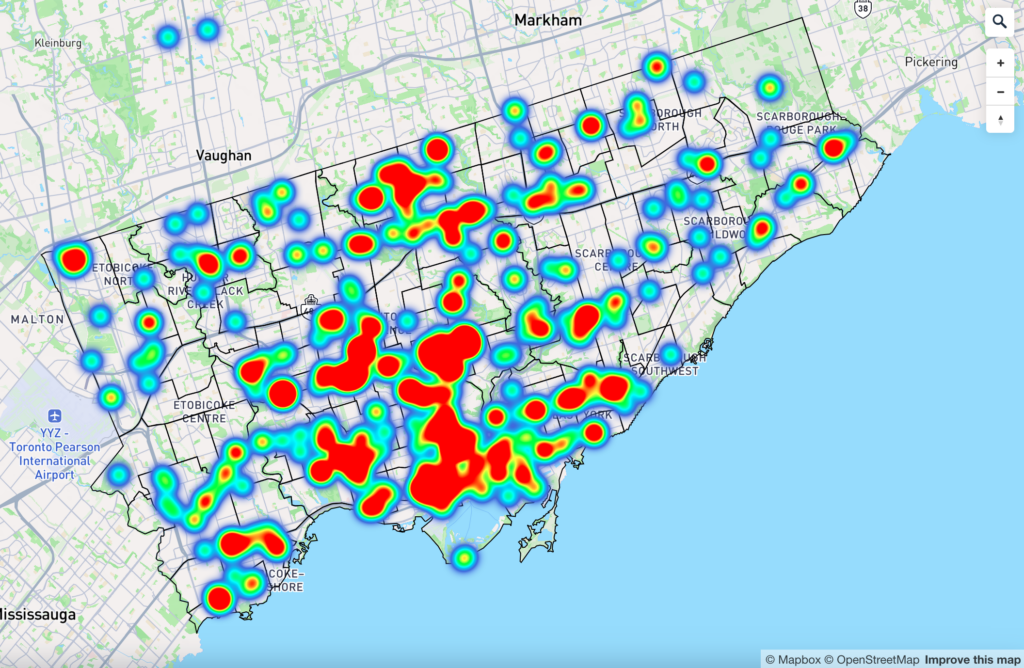
Listen to the whole story here:
New data reveals that zoning amendments (OZ) dominate Toronto’s development landscape, accounting for more than half of all applications in the past year.
According to 2024 data from the City of Toronto, over 800 development applications were submitted in the past 12 months. As Toronto grapples with housing shortages, five wards stand out as the most active in terms of applications for new projects: Toronto-St. Paul’s, Toronto Centre, Willowdale, Eglinton-Lawrence, and Don Valley West.
“Zoning amendments are always complex, bureaucratic, processes,” said Ash Navabi, a research analyst at UrbanToronto. These amendments allow for increased density or changes in land use, according to Navabi. “From looking at the data, areas around Yonge-Eglinton and St. Clair West are going to see a lot of intense development.”
Toronto-St. Paul’s leads this trend, with 60 zoning amendment applications, followed closely by Eglinton-Lawrence and Willowdale.
In contrast, Toronto Centre has seen a high number of site plan applications (SA), indicating a surge in new building proposals and modifications to existing properties. Meanwhile, Don Valley West has a significant share of subdivision applications (CD), suggesting an uptick in multi-unit residential projects such as townhouses and condominiums.
| Ward | Zoning Changes (OZ) | Site Plans (SA) | Subdivisions (CD) | Plans of Subdivision (PL) | Minor Subdivisions (SB) |
|---|---|---|---|---|---|
| Toronto-St. Paul’s | 60 | 3 | 17 | 0 | 0 |
| Toronto Centre | 35 | 27 | 4 | 2 | 1 |
| Willowdale | 44 | 14 | 5 | 0 | 0 |
| Eglinton-Lawrence | 45 | 7 | 3 | 3 | 3 |
| Don Valley West | 21 | 18 | 17 | 2 | 0 |
“There’s been a push in housing trends to refocus on developing individual homes and creating fourplexes and six plexes in more residential areas with less focus on towers,” said Geoff Hayworth, policy coordinator at the Federation of Metro Tenants’ Association.
“Total application numbers have gone down in 2024,” said Navabi. “It’s very risky financially to start building, let alone start proposing because costs are unpredictable.”
The Planning Act and the City of Toronto Act provide legal frameworks that guide planning and zoning, ensuring that development aligns with the city’s Official Plan. Development applications must go through a multi-stage approval process, including community consultations and council approvals, before moving forward.
“It takes years from the time an application is filed to the time construction begins,” said Navabi.
The Federation of Metro Tenants’ Associations highlights that city planners engage with stakeholders at various stages to balance growth with community needs. “Because of the housing crisis going on here, the government has created a tax incentive for developers to build purpose-built rentals instead of just condo buildings,” said Navabi. “We saw a lot more of that happening in 2024.”
“I think it’s a tacit admission that the condo market is failing and we need to be building rentals,” said Hayworth. “Market rentals being built is fantastic, even though they won’t be rent controlled. It seems as if we’re headed in a direction of increasing rentals so that we can at least get some people housed, instead of housing just being a money grab.”
Despite the influx of applications, the majority remain under review (74 per cent). Only a small number have reached the final approval stage, while, according to the 2024 data, 46 applications have been appealed to the Ontario Land Tribunal (OLT, although it is referred to as the Ontario Municipal Board in the City’s data), which means that projects are being debated by city council and other stakeholders.
A spatial analysis of development applications shows that growth is concentrated in midtown and downtown neighbourhoods, aligning with city planning goals of increasing density in transit-accessible areas.
“Development is really kicking up along the Ontario Line,” said Hayworth. “Housing is increasing near these new stops to make it a useful place.”
